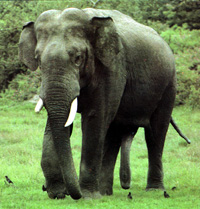
Two typical characteristics have been recognised that differ Borneo elephants from Asian elephants (referred from the website of WWF - Malaysia - Petaling Jaya, Malaysia - 3 Sep 2003):
They are relatively tame and mild-tempered
Borneo's elephants are also smaller in size
Photo. Elephant from Thailand (in the Golden Triangle).
Origin of the Borneo's elephants
Where do the Borneo's Pygmy Elephants descend from? Are they introduced to the area or are they indigenous? This question has been discussed for a long time. Researchers have come up with two main theories. One theory suggested that they are descended from tame elephants presented as gifts to the Sultan of Sulu by the British East India Company in the 17th century.
The second theory argued that they are indigenous to Borneo, arriving from Sumatra via a bridge of swampy land when sea levels were lower during the ice age more than 10,000 years ago and then isolated on the island after the sea level rose and made it impossible to go elsewhere or return to Sumatra.
DNA-testing
Represents from WWF have collected dung from elephants in the Sabah province in order to perform DNA testing on cells found in fresh dung. Using this method it's not necessary to capture elephants for testing, which is good for the elephants.
The dung samples were sent to Columbia University's Department of Ecology, Evolution and Environmental Biology for DNA analysis and comparison with DNA from Asian elephants from Sri Lanka, India, Bhutan, Bangladesh, Thailand, Laos, Vietnam, Cambodia, Peninsular Malaysia, and Sumatra.
WWF reports that the DNA analysis showed that Borneo's elephants were isolated about 300,000 years ago from their cousins on mainland Asia and Sumatra.
Since then, the elephants have
become smaller,
got relatively larger ears,
longer tails,
and relatively straight tusks.
The result of the DNA-analysis verifies also that the Borneo's elephant is a genetically distinct subspecies, and that they were not introduced to the island in the 17th century. The genetic distinctiveness of Borneo elephants makes them one of the highest priority populations for conservation.
WWF is very conscious of that these elephants should not be crossbred with other Asian elephants. Further research should be conducted on their reproductive rates, juvenile survival, and other indicators of detrimental effects of inbreeding.
Stein Morten Lund, 20 September 2003
Additional information
Dung samples were collected from the lower Kinabatangan, Kalabakan Forest Reserve, Gunung Rara Forest Reserve, and Ulu Segama Forest Reserve, Sabah.
The study was made possible by support from the Sabah Wildlife Department, Malaysia, Columbia University, US, and WWF's Asian Rhino and Elephant Action Strategy (AREAS) Programme, and by funding from WWF, Ms Nancy Abraham, and the US Fish and Wildlife Service Division of the International Conservation Asian Elephant Conservation Fund.
For further information contact:
Teoh Teik Hoong
WWF-Malaysia
Tel: +60 3 7803 3772
E-mail: thteoh@wwf.org.my
WWF`s website: www.panda.org
